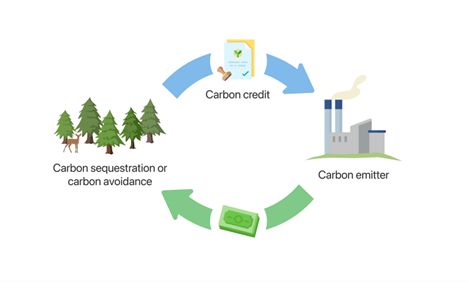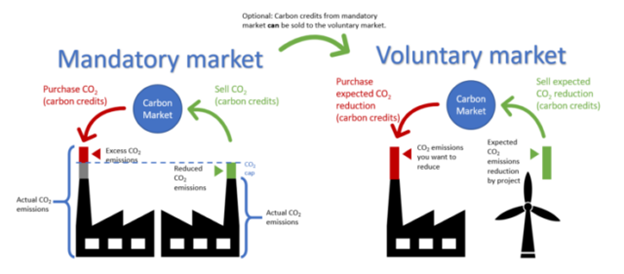Contact: +91 99725 24322 |
Menu
Menu
Quick summary: Explore the world of GHG accounting in the Voluntary Carbon Market in our blog. Learn how accurate data management and verification are shaping a sustainable future. Join us on the journey to a greener planet.

In a world grappling with the pressing issue of climate change, GHG accounting has taken center stage. Understanding the magnitude of emissions and their impact on our planet is crucial for mitigating climate change. Within this context, the voluntary carbon market (VCM) plays a significant role in addressing emissions.
In this blog let’s deep dive into the importance of GHG accounting, its role in the VCM, and the principles and processes involved in accurate accounting.
Before we dive into GHG accounting, it’s essential to grasp what greenhouse gases are and why they matter. Greenhouse gases are substances in the Earth’s atmosphere that trap heat from the sun, leading to the greenhouse effect. The major greenhouse gases include carbon dioxide (CO2), methane (CH4), nitrous oxide (N2O), and fluorinated gases. These gases are emitted from various sources, including energy production, transportation, agriculture, and industrial processes.
The accumulation of these gases in the atmosphere results in global warming, leading to rising temperatures, extreme weather events, and sea-level rise. It’s clear that understanding and controlling GHG emissions are essential for curbing climate change.
The VCM is a pivotal player in addressing climate change, allowing businesses and individuals to voluntarily offset their GHG emissions. This market enables the purchase of carbon offsets, which are investments in projects that reduce or remove GHGs from the atmosphere, such as reforestation initiatives or renewable energy projects. The VCM provides a platform for taking responsibility and reducing one’s carbon footprint.

Engaging in the VCM offers several benefits. For businesses, it enhances corporate social responsibility, boosts sustainability initiatives, and can even attract environmentally conscious consumers. Individuals can offset their personal carbon emissions, aligning their actions with their climate-conscious values. Additionally, supporting carbon offset projects can promote clean energy development and reforestation.
Accurately measuring GHG emissions and the carbon sequestration benefits resulting from a project is of paramount importance for the effective operation of carbon markets and the attainment of greenhouse gas reduction targets, which incentivize active participation in these markets.
GHG accounting is the foundation of the VCM, ensuring that carbon offsets are credible and effective. Accurate accounting is crucial, as it determines the true impact of emissions and the effectiveness of offset projects.
Accurate GHG accounting is vital for several reasons. It allows businesses and individuals to understand their carbon footprint and the emissions associated with their activities. This knowledge is the first step in making informed decisions and taking action to reduce emissions. Moreover, it ensures that the offsets purchased in the VCM truly represent emissions reductions, which is essential for the market’s credibility.
Carbon accounting for a mitigation activity typically entails a comparison between the emissions and sequestration linked to the project in question and a baseline scenario that depicts what emissions and sequestration would occur without the activity. To qualify for carbon credits, the project must demonstrate a positive variance in greenhouse gas reduction, greenhouse gas removals, or carbon sequestration when compared to the baseline scenario.
Quantifying project emissions and sequestration typically requires a mix of approaches, including the use of emission factors, process-based modelling, and direct measurements of emissions or sequestration. While direct measurements of emissions are practical for specific point-source activities like methane combustion from manure digesters, many agriculture and forestry protocols primarily employ dynamic modelling and random sampling methods. This is due to the inherent variability in emissions and sequestration observed in agricultural and forestry sources.

Various standards and protocols guide GHG accounting. Notable ones include the Greenhouse Gas Protocol, ISO 14064, and the Verified Carbon Standard. These standards provide a structured framework for measuring, reporting, and verifying emissions data, ensuring consistency and credibility in the VCM.
To achieve accurate GHG accounting, specific steps must be followed:
Identifying Emissions Sources
The first step involves identifying and categorizing emissions sources. For businesses, this includes activities such as energy consumption, transportation, and industrial processes. Individuals may consider their energy usage, transportation choices, and lifestyle.
Measuring Emissions
Accurate measurement of emissions is the core of GHG accounting. This often involves collecting data on fuel consumption, energy usage, and other relevant factors. Businesses may need to install monitoring equipment, while individuals can use online calculators to estimate their emissions.
Reporting and Verification
Once emissions data is collected, it must be reported in a clear and transparent manner. This is where the GHG accounting standards and protocols come into play, ensuring the data’s accuracy and credibility. Third-party verification is often employed to provide an unbiased assessment of the reported emissions data.
Offsetting Emissions
The final step involves offsetting emissions through the purchase of carbon offsets. These offsets are investments in projects that reduce or remove GHGs equivalent to the emissions being offset. For instance, if a business emits 1,000 tons of CO2, it can purchase 1,000 tons of carbon offsets from a project that reduces or removes an equivalent amount of CO2 from the atmosphere.
Accurate GHG accounting involves a range of key players:
Businesses are central to GHG accounting, as they are major emitters of GHGs. They must assess, measure, and report their emissions, as well as invest in carbon offset projects to neutralize their impact. This not only demonstrates corporate responsibility but also fosters a more sustainable business model.
Carbon offset developers play a critical role in the VCM. They develop and manage projects that reduce or remove GHGs from the atmosphere. These projects can include renewable energy initiatives, reforestation, and methane capture at landfills. Businesses and individuals purchase carbon offsets from these providers to offset their emissions.
The central aim of verification is to have an impartial third party assess whether a project has adhered to the stipulated protocol requirements and if the carbon credits to be issued can be reasonably assured as accurate. Verification takes place subsequent to the implementation of carbon reduction/sequestration activities, which may span one or more reporting periods based on the specific protocol’s demands.
Third-party verifiers are independent organizations responsible for assessing and verifying the emissions data reported by businesses and individuals. Their role is to ensure that the accounting process adheres to standards and protocols and that the data is accurate and transparent.
Despite the importance of GHG accounting, several challenges exist:
Common Challenges in GHG Accounting
Common challenges include data accuracy, availability, and completeness. Small businesses and individuals may lack the resources or expertise to perform comprehensive accounting. Additionally, verifying emissions data can be complex, particularly for entities with diverse emissions sources.
The obligations related to record-keeping and data collection can sometimes act as obstacles to engagement in carbon markets. This is especially the case in protocols that necessitate comprehensive data collection to record continuous activities, along with historical production and management data for precise estimation and documentation of greenhouse gas (GHG) benefits.
Accurately measuring baseline and project emissions or sequestration for projects within ecological systems, particularly in agriculture and forestry, presents an even greater challenge. This is due to the inherent variability in these systems, which encompasses factors like weather, forest species, soil types, and their influence on baseline and project scenarios, including variables like yields.
Among the annual expenses for carbon credit projects in the agriculture and forestry sectors, verification costs stand out as significant. These costs are linked to activities essential for verification bodies to attain a reasonable level of confidence in the reliability of carbon credits. Such activities encompass the review of project data, risk-based sampling, and, in certain instances, protocols employing process-based models may necessitate verifiers to re-run these models with project data to validate the accuracy of the model outcomes.
Maintaining transparency and credibility is essential. Any perception of “greenwashing,” where entities claim to be more environmentally friendly than they are, can damage the VCM’s integrity. Rigorous adherence to standards and third-party verification helps prevent such issues.
Practices aimed at preserving or enhancing biomass and soil carbon face the risk of reversal. In instances where the forest connected to a carbon sequestration project is subjected to a fire or a no-till field is tilled, a substantial portion of the carbon previously stored in biomass or soil may be liberated as carbon dioxide. This essentially “reverses” the credited carbon storage achieved through the project. Reversal events can occur due to factors that are beyond control, like fires, or factors that could have been prevented, such as tilling.
Leakage arises when actions within a project that decrease emissions or boost sequestration lead, either directly or indirectly, to activities beyond the project’s boundaries that raise emissions or reduce sequestration. Leakage, along with secondary effects, introduces complexities in accurately measuring the benefits linked to agricultural and forestry projects.
To be eligible for carbon credits, the emissions reductions or carbon sequestration accomplished by an agricultural or forestry project must be considered “additional” compared to what would have occurred without the project (the baseline). Establishing a baseline for determining additionality is a complex task. It involves creating a counterfactual scenario that takes into account all the factors and influences that would have affected behaviour and emissions/sequestration in the absence of the project.
Technology is playing an increasingly significant role in streamlining GHG accounting. Software solutions and online calculators make data collection and reporting more accessible. Data automation and blockchain technology also enhance the transparency and traceability of carbon offsets.
Tracex DMRV solutions contribute significantly to the credibility and accuracy of GHG accounting in the Voluntary Carbon Market. They streamline the process, provide real-time data insights, ensure transparency, and facilitate adherence to market standards, ultimately supporting the VCM’s goal of reducing emissions and promoting sustainable practices.
As we look to the future, several trends are emerging in GHG accounting:
New methodologies and tools are constantly being developed to improve the accuracy and efficiency of GHG accounting. Artificial intelligence and machine learning are being employed to analyze emissions data and identify trends for more effective emissions reduction strategies. GHG accounting is central to achieving climate goals. Accurate accounting ensures that emissions are properly quantified and that offset projects deliver the expected reductions. As nations and organizations set more ambitious emissions reduction targets, GHG accounting becomes even more critical.
GHG accounting is the linchpin of the voluntary carbon market, offering a powerful tool for individuals and businesses to measure, reduce, and offset their emissions. With the world facing the dire consequences of climate change, understanding the importance of GHG accounting and its role in the VCM is paramount. As we navigate the path to a greener future, accurate accounting practices will be our guiding light, ensuring transparency, credibility, and ultimately, a more sustainable world for all. By embracing GHG accounting and the VCM, we take a significant step towards mitigating climate change and securing a better future for our planet.
